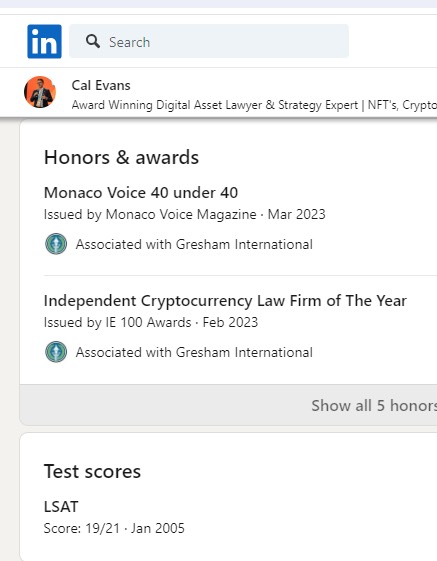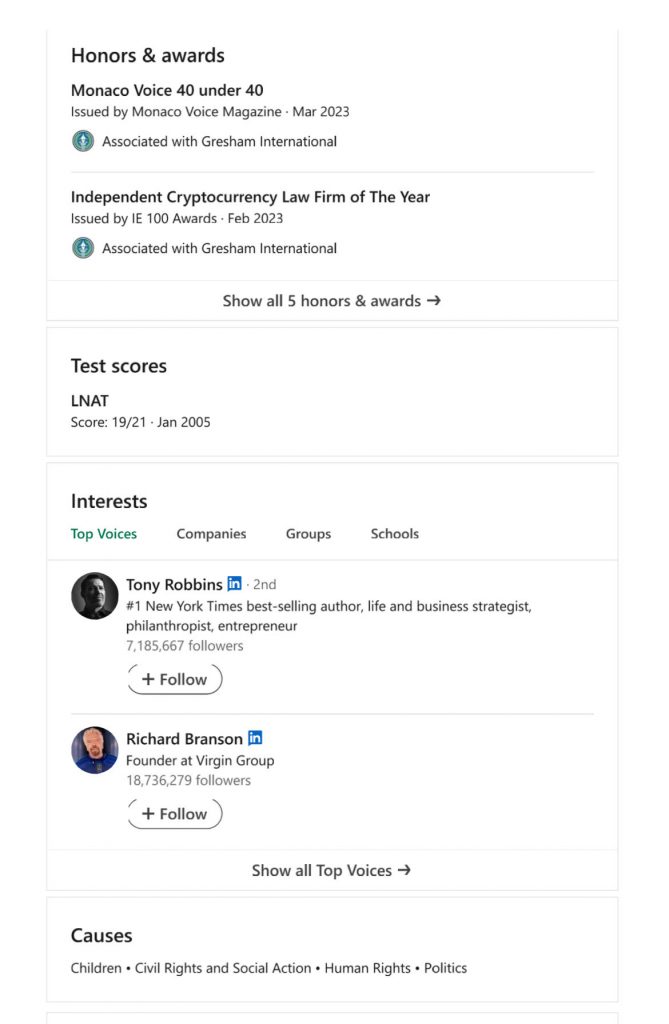DISCLOSURE: DUNSMOOR LAW IS CLOSED AS OF NOVEMBER 2, 2023. SEE DUNSMOOR.IO THIS INFORMATION IS TO PROTECT THE INVESTING PUBLIC. NOTHING IN THIS ARTICLE IS LEGAL, FINANCIAL OR INVESTMENT ADVICE.
TL;DR: Admissions exams don’t really matter beyond the point at which they were administered. Be wary of anyone who brags about admissions test scores, especially scores over a decade old, or lies about the scores they received, because the scores do not correlate with proper scoring.
In our ongoing series on basic due diligence, we turn our attention to admissions exams, specifically in the context of legal education. This article aims to clarify common misconceptions and highlight the importance of verifying claims about test scores, using the case of Cal Evans of Gresham International as an instructive example because he has recently changed his LSAT score to an LNAT score. However, as we discuss here, there are still problems with that attempt.
Admissions Exams: LSAT vs. LNAT
Two prominent admissions tests for law school are the Law School Admission Test (LSAT) used in North America and the Law National Aptitude Test (LNAT) used in the UK. While these exams and their usefulness have been questioned, the LSAT is still the standard for admissions in the United States. It’s crucial to understand the differences between these exams and their scoring systems.
- LSAT (Law School Admission Test):
- Scoring range: 120-180
- A score of 170 or above is typically considered excellent
- LNAT (Law National Aptitude Test):
- Current format: 42 multiple-choice questions scored out of 42, plus an essay
- 2005 format: 30 multiple-choice questions scored out of 30, plus an essay
- Competitive scores are typically in the high twenties to low thirties
The Case of Cal Evans
Cal Evans, associated with Gresham International, initially claimed on his LinkedIn profile to have scored 19/21 on the LSAT. This claim raised immediate red flags for several reasons:
- The LSAT is not scored out of 21
- A score of 19 on the LSAT’s actual scale (120-180) would be exceptionally low and technically impossible.
When this discrepancy was pointed out, Evans apparently changed his claim to scoring 19/21 on the LNAT. However, this revised claim is equally problematic:
- The LNAT has never been scored out of 21
- Even in its 2005 format, the LNAT was scored out of 30
Visual Evidence of Changing Claims

Original LinkedIn profile claim showing “19/21 on LSAT” captured April 2024 (Email me for the full profile)
This screenshot provides clear evidence of Evans’ initial misrepresentation, claiming an LSAT score on a non-existent scale.

Updated LinkedIn profile claim showing “19/21 on LNAT” captured July 2024 and currently available on his LinkedIn profile.
This second screenshot demonstrates the attempt to rectify the initial error by changing the test name, yet still maintaining an incorrect scoring scale.
These images serve as concrete evidence of the pattern of misrepresentation and the attempt to obscure the initial false claim by Evans. There is an established pattern when individuals are caught in deception; they often attempt to modify the falsehood to fit their narrative and then try to obscure the evidence. In this case, Evans was initially called out on the LSAT score, which must fall within the range of 120 to 180. In an apparent attempt to conceal the fact that he lied, he changed it to an LNAT score, presumably intending to claim it was a typo. However, this explanation is highly implausible given that the “N” and “S” keys are nearly as far apart on a keyboard as possible, and the LSAT and LNAT are distinct tests for different countries.
Furthermore, in an effort to perpetuate the deception, Evans modified the letter but neglected to research the actual LNAT scoring scale during that time period, which was out of 30. Converting the claimed scores to percentages reveals that the initial ’19/21′ equates to 90.48%, while ’21/30′ translates to 70%, a difference of 20.48 percentage points.
This series of events clearly demonstrates a pattern of misrepresentation and deceit, reminiscent of notorious scam artists such as Bernie Madoff and Elizabeth Holmes of Theranos, where minor discrepancies are often dismissed by others. However, such inconsistencies should not be overlooked, particularly when they involve individuals who claim to be “award winning lawyers.”
They also underscore the importance of capturing and preserving such information when conducting due diligence, as online profiles can be altered quickly to hide discrepancies.
As we have discussed in our Cal Evans of Gresham International is a Scammer Series, this pattern of misrepresentation raises serious questions about the veracity of Evans’ claims and his understanding of basic legal education standards as well as the work he has conducted in this area of the law as a so-called “International Lawyer.”
The Irrelevance of Admissions Test Scores Post-Education
It’s important to note that admissions test scores become largely irrelevant once an individual has completed their legal education. Professional competence is typically judged based on:
- Academic performance during law school
- Bar exam results (where applicable)
- Professional experience and reputation
Individuals who continue to emphasize their admissions test scores years after completing their education may be attempting to bolster their credentials inappropriately.
Red Flags in Claims About Admissions Tests
When conducting due diligence on legal professionals, be wary of:
- Emphasis on admissions test scores long after completing education
- Scores that don’t align with known scoring systems
- Vague or changing claims about test performance
These may indicate a lack of more substantial professional achievements or an attempt to mislead about qualifications.
Verification Challenges
It’s important to note that verifying claims about admissions test scores is often impossible without the individual’s consent. Testing organizations typically do not release scores to third parties without authorization. This lack of verifiability makes such claims particularly susceptible to manipulation.
Conclusion
The case of Cal Evans serves as a cautionary tale about the importance of critical evaluation when assessing claims of professional qualifications. In the legal field, where integrity is paramount, any misrepresentation of credentials should be viewed as a serious concern.
When conducting due diligence:
- Focus on verifiable qualifications such as degrees and bar admissions
- Be skeptical of emphasis on decades-old test scores
- Look for consistency and accuracy in all claims of educational achievement
Remember, true legal expertise is demonstrated through professional accomplishments and peer recognition, not through questionable claims about admissions tests taken years ago.
By understanding these basic due diligence techniques, you can better protect yourself from potential misrepresentation, which may have material consequences to your investors, and ensure you’re working with qualified, ethical legal professionals.
